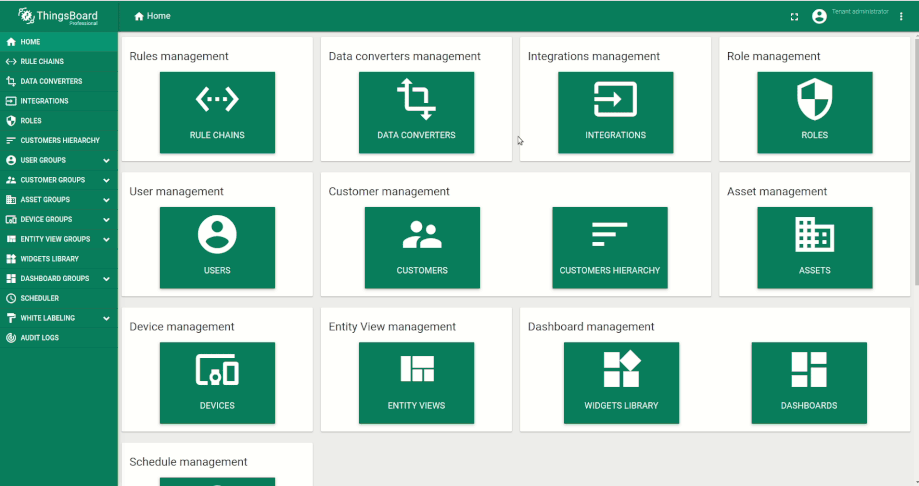Custom Integration

|
ThingsBoard PE Feature Only ThingsBoard Professional Edition supports Platform Integrations feature. See ThingsBoard PE Installation Options to install ThingsBoard PE. |
- Introduction
- Prerequisites
- Uplink and Downlink Converters
- Custom Integration Setup
- Custom Integration Application
- Next steps
Introduction
Custom integration is only executed remotely from the main ThingsBoard instance. It allows to create integration with custom configuration that will use any transport protocol for communication with your devices.
This guide contains step-by-step instructions on how to create and launch ThingsBoard custom integration. For example, we will launch custom integration that uses TCP transport protocol to stream data from devices and pushes the converted data to cloud.thingsboard.io.
Before we start, you can find the full code of custom integration example that we will use in this guide here.
Prerequisites
We assume you already have a tenant administrator account on your own ThingsBoard PE v2.4.1+ instance or cloud.thingsboard.io.
Let’s assume that we have a sensor which is sending current temperature, humidity and battery level readings respectively in the following format: “25,40,94”.
Uplink and Downlink Converters
Before setting up a custom integration, you need to create an Uplink and a Downlink converters.
Uplink Converter
Let’s create uplink converter.

NOTE: Although the Debug mode is very useful for development and troubleshooting, leaving it enabled in production mode may tremendously increase the disk space, used by the database, because all the debugging data is stored there. It is highly recommended to turn the Debug mode off when done debugging.
See the following script that is pasted to the Decoder function section:
/** Decoder **/
// decode payload to string
var decodedString = decodeToString(payload);
// remove unnecessary [\"] and split by [,] to get an array
var payloadArray = decodedString.replace(/\"/g, "").split(',');
var result = {
deviceName: "Device A",
deviceType: "type",
telemetry: {
// get each reading from the array and convert the string value to a number
temperature: Number(payloadArray[0]),
humidity: Number(payloadArray[1]),
batteryLevel: Number(payloadArray[2])
},
attributes: {}
};
/** Helper functions **/
function decodeToString(payload) {
return String.fromCharCode.apply(String, payload);
}
function decodeToJson(payload) {
// convert payload to string.
var str = decodeToString(payload);
// parse string to JSON
var data = JSON.parse(str);
return data;
}
return result;
The purpose of the decoder function is to parse the incoming data and metadata to a format that ThingsBoard can consume. deviceName and deviceType are required, while attributes and telemetry are optional. Attributes and telemetry are flat key-value objects. Nested objects are not supported.
Downlink Converter
We will not use the Downlink converter in this guide so there is no need to create one. In case you have another use case, please refer to the following instructions.
Custom Integration Setup
Let’s create custom integration.

Notice that Execute remotely is enabled automatically when we choose Custom type and we enable Debug mode.
Integration class is used to create an instance of the integration using the Java reflective method.
The Integration JSON configuration is the custom configuration that has two fields in our case:
- port, which will be used to bind the TCP server-client communication
- msgGenerationIntervalMs, the interval between generating the messages
We will get back to this later in this guide.
Custom Integration Application
Download the sample application
Feel free to grab the code from the ThingsBoard repository and build the project with maven:
mvn clean install
Go ahead and add that maven project to your favorite IDE.
Dependencies review
Main dependencies that are used in the project:
<!-- Api ThingsBoard provides to create custom integration -->
<dependency>
<groupId>org.thingsboard.common.integration</groupId>
<artifactId>remote-integration-api</artifactId>
<version>${thingsboard.version}</version>
</dependency>
<!-- Netty for TCP client-server implementation -->
<dependency>
<groupId>io.netty</groupId>
<artifactId>netty-all</artifactId>
<version>${netty.version}</version>
</dependency>
<!-- Grpc transport between remote integration and ThingsBoard -->
<dependency>
<groupId>io.grpc</groupId>
<artifactId>grpc-netty</artifactId>
<version>${grpc.version}</version>
</dependency>
Source code review
Main source code is the CustomIntegration Java class. Integration is expecting “Hello to ThingsBoard” message from the TCP client and replies with the “Hello from ThingsBoard!”. Once the client emulator receives “Hello from ThingsBoard!” , it will start sending auto-generated data to ThingsBoard in the following format: “25,40,94”. The Integration will pass the incoming message as-is to the uplink converter and push data to ThingsBoard.
Next steps
-
Getting started guides - These guides provide quick overview of main ThingsBoard features. Designed to be completed in 15-30 minutes.
-
Installation guides - Learn how to setup ThingsBoard on various available operating systems.
-
Data visualization - These guides contain instructions how to configure complex ThingsBoard dashboards.
-
Data processing & actions - Learn how to use ThingsBoard Rule Engine.
-
IoT Data analytics - Learn how to use rule engine to perform basic analytics tasks.
-
Hardware samples - Learn how to connect various hardware platforms to ThingsBoard.
-
Advanced features - Learn about advanced ThingsBoard features.
-
Contribution and Development - Learn about contribution and development in ThingsBoard.